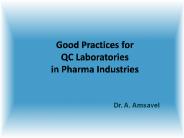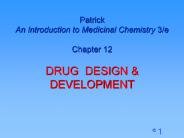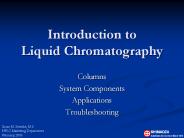Cationic Reagent Market PowerPoint PPT Presentations
All Time
Recommended
Cationic reagents, a category of chemical compounds with positive charges, play a crucial role in various industrial applications such as water treatment, textiles, paper, and personal care. The global cationic reagents market has shown steady growth, driven by increasing industrialization, stringent environmental regulations, and growing demand for cationic compounds in multiple industries. According to Persistence Market Research analysts, the cationic reagents market is expected to grow at a CAGR of 3.5%, from a valuation of US$ 305.0 million in 2023 to an estimated US$ 430.3 million by 2033.
| PowerPoint PPT presentation | free to download
Download free PDF Sample@ https://bit.ly/3dUirRC #ChemicalsAndMaterials #Chemicals #MarketAnalysis #Reagent Cationic Reagent report also analyses the impact of Coronavirus COVID-19 on the its industry. Based on our recent survey, we have several different scenarios about the Cationic Reagent YoY growth rate for 2020. The probable scenario is expected to grow by a xx% in 2020 and the revenue will be xx in 2020 from US$ xx million in 2019. The market size of Cationic Reagent will reach xx in 2026, with a CAGR of xx% from 2020 to 2026.
| PowerPoint PPT presentation | free to download
Adsorption Chromatography Reagents Market
| PowerPoint PPT presentation | free to download
Request for TOC report @ http://bit.ly/2mnHaYA Based on end-user, flotation reagents market is bifurcated into mining & drilling, oil & gas, wastewater treatment, and others. Wastewater treatment segment is expected to grow significantly with growing flocculants flotation reagents demand for treating industrial and residential wastewater in the coming years. Mining & drilling industry is another key end-user industry which require flotation reagents for refining and processing Sulphur, non-Sulphur and other mineral ores, including coal. In oil & gas industry, product is used to separate the sediments and unwanted particles during the oil drilling operations. Rising product demand from the aforementioned end-user industry will significantly aid the market size in the coming years.
| PowerPoint PPT presentation | free to download
The market has witnessed a large number of advancements in the design of columns and the development of better performing resins and reagents. The market is valued at $4,598.0 million in 2013 and to reach $7,609.3 million by 2018, at a CAGR of 10.6%.
| PowerPoint PPT presentation | free to download
Chromatography Reagents Market categories by Type [Acylation, Alkylation, Solvent, Buffer], Bed Shape [Column, Thin layer], Mobile Phase [UHPLC, HPLC, HILIC, Flash, SFC], Separation Mechanism [Partition, Adsorption, Affinity] & End User.
| PowerPoint PPT presentation | free to download
Chromatography Reagents Market categories by Type [Acylation, Alkylation, Solvent, Buffer], Bed Shape [Column, Thin layer], Mobile Phase [UHPLC, HPLC, HILIC, Flash, SFC], Separation Mechanism [Partition, Adsorption, Affinity] & End User.
| PowerPoint PPT presentation | free to download
The global temperature management market is estimated to grow at a CAGR of 2.4% from 2014 to 2019. Although mature markets such as the U.S., Germany, and U.K. hold larger shares in the temperature management market in 2014, the Asia-Pacific region is poised to grow at the highest CAGR of 3.4% in the next five years. The global temperature management market is highly competitive, with a large number of global and local players. See Full Report : http://bit.ly/ZXRBlm
| PowerPoint PPT presentation | free to download
ResearchAarkstore Enterprise Clinical Laboratory Testing Volume 1 IVD Reagents and Instruments Markets
| PowerPoint PPT presentation | free to download
The North American ion pairing reagents report defines and segments the concerned market in North America with analysis and forecast of revenue.
| PowerPoint PPT presentation | free to download
According to the latest research report by IMARC Group, The global transfection technologies market size reached US$ 1,080.2 Million in 2022. Looking forward, IMARC Group expects the market to reach US$ 1,747.7 Million by 2028, exhibiting a growth rate (CAGR) of 8.5% during 2023-2028. More Info:- https://www.imarcgroup.com/transfection-technologies-market
| PowerPoint PPT presentation | free to download
According to the latest research report by IMARC Group, The United States transfection technologies market size reached US$ 359 Million in 2022. Looking forward, IMARC Group expects the market to reach US$ 557 Million by 2028, exhibiting a growth rate (CAGR) of 7.6% during 2023-2028. More Info:- https://www.imarcgroup.com/united-states-transfection-technologies-market
| PowerPoint PPT presentation | free to download
According to the latest research report by IMARC Group, The global virus filtration market size reached US$ 3.9 Billion in 2022. Looking forward, IMARC Group expects the market to reach US$ 6.9 Billion by 2028, exhibiting a growth rate (CAGR) of 9.5% during 2023-2028. More Info:- https://www.imarcgroup.com/virus-filtration-market
| PowerPoint PPT presentation | free to download
Looking forward, the transfection technologies market value is projected to reach a strong growth during the forecast period (2021-2026). More info:- https://www.imarcgroup.com/transfection-technologies-market
| PowerPoint PPT presentation | free to download
In oil & gas industry, CHPTAC has wide utility as cationic reagent and has the highest CAGR. It is used in the formulation of drilling mud which is viscous and heavy fluid mixture required for oil and gas drilling operations.
| PowerPoint PPT presentation | free to download
Global Specialty chemicals market is expected to reach $233.5 billion by 2020. Specialty chemicals are manufactured for specific performance and functions in different end use industries. There are numerous specialty chemicals used in several end-user industries, globally; however, specialty chemicals included in this report are food additives, cosmetic chemicals, water treatment chemicals, paper & pulp chemicals, textile chemicals, construction chemicals, and oil field chemicals. Request sample copy of this report at: https://www.alliedmarketresearch.com/request-sample/447
| PowerPoint PPT presentation | free to download
Szu-Wei Yang, Charles W. Kanyi, J rgen T. Schulte, Justin B. Sanbur, Jack D. Fox, ... Stoichiometry of Na0/CH3I hard to control, as is sodalite Na43 (NaY), Na65 (NaX) ...
| PowerPoint PPT presentation | free to view
Propyl Acetate Market Set for Rapid Growth and Trend, by 2024
| PowerPoint PPT presentation | free to download
Global transfection technologies market is registering a substantial CAGR of 9.74% in the forecast period of 2019-2026. This rise in the market can be attributed to surge in research & development in the field of cell based therapies and massive funds by government and private players.
| PowerPoint PPT presentation | free to download
Global transfection technologies market is registering a substantial CAGR of 9.74% in the forecast period of 2019-2026. This rise in the market can be attributed to surge in research & development in the field of cell based therapies and massive funds by government and private players.
| PowerPoint PPT presentation | free to download
General Electric Co., Toshiba Corporation, Koninklijke Philips N.V., Siemens AG, Hitachi, Ltd., Positron Corporation, Mediso Ltd., and Yangzhou Kindsway Biotech Co. Ltd. are some of the leading players operating in the global Positron Emission Tomography (PET) scanners market.
| PowerPoint PPT presentation | free to download
Further, the textile industry is the largest consumer industry and plays a vital role to increase the economical rate. 3-Chloro-2-Hydroxypropyl Trimethylammonium Chloride is made to react with the cotton fibre and enhancing the bond with dye. It also gives ant-bacterial properties to the the cationic cotton whilst reducing the water consumption. Thus the wide applicability of technical textile is considered as a major factor, fuelling the market growth.
| PowerPoint PPT presentation | free to download
Diisopropylbenzene Market 2018 to 2023 | Application, Types & Regional Analysis
| PowerPoint PPT presentation | free to download
Mobile Gamma Cameras Market: Single Head Gamma Camera Segment Expected to Remain Dominant During the Forecast Period: Global Industry Analysis (2013 - 2017) & Opportunity Assessment (2018 - 2028)
| PowerPoint PPT presentation | free to download
Diisopropylbenzene Market Performance, Feasibility Key Players, Consumption Status, Production, Regions, Report 2018-2023
| PowerPoint PPT presentation | free to download
Diisopropylbenzene Market Expected to Retain Dominance & Grow at an Encouraging CAGR to 2023
| PowerPoint PPT presentation | free to download
PolyDADMAC also called as pdda, is used in water purification and influent water treatment. It is also being used for the removal of inorganic and organic particles such as silt, clay, algae, bacteria and viruses and makes low chloride levels.
| PowerPoint PPT presentation | free to download
Type 2 pure water is one of the most common reagents. It is used by scientists, researchers, and engineers everywhere in environments as diverse as academic, hospital, and quality control laboratories. In spite of its importance, many water purification systems on the market are not able to reliably provide pure water of consistent quality in the daily volumes required by users.
| PowerPoint PPT presentation | free to download
The report provides a complete roadmap for setting up an ammonium bromide manufacturing plant. It covers a comprehensive market overview to micro-level information such as unit operations involved, raw material requirements, utility requirements, infrastructure requirements, machinery and technology requirements, manpower requirements, packaging requirements, transportation requirements, etc.
| PowerPoint PPT presentation | free to download
The report provides a complete roadmap for setting up an sodium fluoride manufacturing plant. It covers a comprehensive market overview to micro-level information such as unit operations involved, raw material requirements, utility requirements, infrastructure requirements, machinery and technology requirements, manpower requirements, packaging requirements, transportation requirements, etc.
| PowerPoint PPT presentation | free to download
Poly DADMAC-Competition by Manufacturers, Market Overview, Capacity, Production, Manufacturers Profiles/Analysis, Revenue (Value) by Region, Supply (Production), Market Analysis by Application, Consumption, Export, Import by Region, Manufacturing Cost Analysis, Industrial Chain, Sourcing Strategy and Downstream Buyers, Market Effect Factors Analysis
| PowerPoint PPT presentation | free to download
Definition Requirements QC Lab Management Documents & Records QC personal Sample Management Reagents & Reference standard Instruments and Calibration Computer System Validation Analytical method Analysis, analytical data & Review Reserve sample Purposes of GMP Documentation Tips to good documentation practices Warning letters and observations
| PowerPoint PPT presentation | free to download
1. Globalisation of Capital Markets ... Wider and easier access to information ... Kone (Finland): cranes mining hoists elevators ...
| PowerPoint PPT presentation | free to view
Improving pH System Design and Performance Roger Reedy - Principal Engineer Greg McMillan - Principal Consultant John Moulis - Principal Engineer
| PowerPoint PPT presentation | free to view
Course LMP 1506S Clinical Applications of Genomics and Proteomics Thursday, April 15, 2004, 9-11 am MSB Room 6205 Eleftherios P. Diamandis MD,Ph.D
| PowerPoint PPT presentation | free to download
Patrick An Introduction to Medicinal Chemistry 3/e Chapter 12 DRUG DESIGN & DEVELOPMENT REGULATORY AFFAIRS Drug must be approved by regulatory bodies Food and Drugs ...
| PowerPoint PPT presentation | free to download
description and principles of GC and HPLC
| PowerPoint PPT presentation | free to download
Absorbance values are determined on a spectrophotometer at 750 nm. ... then easily determined with a spectrophotometer using a standard curve with ...
| PowerPoint PPT presentation | free to view
Jay E. Slater, MD, Lab Chief Supervisory Medical Officer (4) ... Cherry Valerio Biologist (2) Katia Dobrovolskaia Visiting associate (2) ...
| PowerPoint PPT presentation | free to view
Amphetamine and Related Drugs Narcotics Narcotics of Natural Origin -Opium -Morphine -Codeine -Thebaine Semi-Synthetic Narcotics -Heroin ...
| PowerPoint PPT presentation | free to view
With an idea to acknowledge the fast-growing companies, contributing extraordinarily to the revolution of disruption in healthcare, we bring to you the special edition of “The 20 Most Disruptive Healthcare Solution Providers 2018”.
| PowerPoint PPT presentation | free to download
novelties in leaching, solvent extraction and electrowinning carlos avenda o v.
| PowerPoint PPT presentation | free to view
| PowerPoint PPT presentation | free to view
Despite these challenges, medical device companies have always been adept with the latest technology and innovations happening in the sector. Keeping this in mind, we bring you the in-depth profiles of- “The 10 Most Innovative Medical Devices Companies 2018.”
| PowerPoint PPT presentation | free to download
Potato Cultivar Development Initiatives in Colorado
| PowerPoint PPT presentation | free to view
The functional group of an ether is an oxygen atom bonded to two carbon atoms ... in ethyl vinyl ether, for example, the ether oxygen is bonded to one sp3 ...
| PowerPoint PPT presentation | free to view
Do not mistake with a distillation where a membrane is just separating phases. ... Purification of H2, CO2, CH4 and gaseous hydrocarbons of difficult distillation. ...
| PowerPoint PPT presentation | free to view
Approx 1000 MORE sensitive than UV detectors. ... intuitive operation Comparison of Corona CAD with other HPLC detectors Unique detection method superior to: ...
| PowerPoint PPT presentation | free to view
Reduction nitroarenes in alkaline medium ... CH3 CH2 NO2 + 3H2 CH3 CH2 NH2 + 2H2O 4.The aromatic nitrocompounds The simplest aromatic nitro compound, ...
| PowerPoint PPT presentation | free to view
PROCESS ANALYTICAL TECHNOLOGIES:
| PowerPoint PPT presentation | free to view
... Ethers & Epoxides Organic Chemistry William H. Brown ... trans-2,3-dimethyloxirane Synthesis of Epoxides A mechanism for alkene ...
| PowerPoint PPT presentation | free to view
Introduction to Liquid Chromatography Columns System Components Applications Troubleshooting Susan M. Steinike, M.S HPLC Marketing Department ...
| PowerPoint PPT presentation | free to download
An inorganic substance with the chemical formula ZnCl2 is Zinc Chloride. A molecule of zinc chloride features ionic bonding between the zinc cation (Zn2+) and the chloride anions (Cl–). Buy online Zinc Chloride at Amizaraspecialitychemicals.co.in at the best price. Visit - https://amizaraspecialitychemicals.co.in/product-range/zinc-chloride/
Analytical Method Validation in The Drug Development Process Kim HyunSung Ph.D. Berna Biotech Korea QC Chemistry lab Contents Introduction The importance of ...
| PowerPoint PPT presentation | free to view
The major categories and sources of air pollution. Conventional & unconventional pollutants ... How air pollution damages human health, vegetation and buildings ...
| PowerPoint PPT presentation | free to view
North America is expected to account for the largest share of the global lateral flow assay market @ http://goo.gl/Q6R3HY . It is followed by Europe, Asia-Pacific, and RoW. However, markets in developed geographies like North America and Europe are expected to grow at lower CAGRs as compared to the Asia-Pacific. This is because the Asia-Pacific region is characterized by favorable factors for market growth, such as rising healthcare awareness, presence of less stringent regulations, improving healthcare infrastructure, and increasing demand for quality healthcare at low costs.
























































